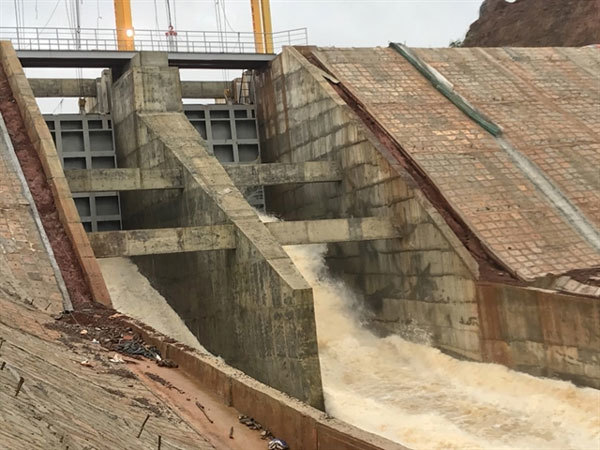with experts warning immediate measures are needed to guarantee the safety of both people and crops.
Heavy rain submerges in central highlands provinces
Family of three buried under landslides in Dak Nong province
 |
| Driftwood can be seen scattered besides the sluice gates of the Dak Kar hydropower plant in the Central Highlands Province of Dak Nong. Driftwood and rubbish brought on by the flooding last week are said to have caused the sluice gates to be jammed up, posing risks of dam burst. — VNA/VNS Photo |
On Thursday afternoon last week, an alarm went off at the plant's dam after its valve door was found to be jammed. Prolonged torrential rains have worsened the situation, and the dam was at heightened risk of bursting.
Around 5,000 people living in Bu Dang District in Binh Phuoc Province, downstream from the plant, were evacuated. More than 300 households in Cat Tien and Da Teh districts were at the ready and will be evacuated in case of an emergency.
Chu Van Quyen, director of Dak Kar Hydro-power JSC, told Thanh Niên (Young People) newspaper that the water volume had increased to more than 12 million cubic metres because of the heavy rains, far above the designed capacity of 11.6 million of cubic metres. Drifting pieces of wood jammed the reservoir's turbines.
By the weekend, rainfall had subsided and sluice gates were opened, dropping the water level by 2.5m.
However, the jammed valve door has still not been fixed.
Quyen said the company would fix the problem soon.
Meanwhile, chief secretariat of Dak Nong Province’s Steering Committee for Disaster Prevention and Control Le Viet Thuan said the plant’s investor failed to make a plan to deal with the daunting weather forecast.
Thuan also said the company's explanation for the damaged valve door was not satisfactory.
He said the valve door was eight metres high, and wood usually floats on the water surface instead of sinking to the level of the valve. He said it was possible the construction unit working to expand the valve had not completed its work.
Over the past few days, none of the stuck wood had been removed, he said.
Vulnerable downstream
Bui Van Hung, chairman of the People's Committee of Cat Tien District, said the district was adjacent to the plant, causing anxiety among residents.
“I have kept in touch with the plant’s director all the time during the heavy rainfall," he said. "Local authorities need to inform people about the situation so they can be ready in an emergency situation."
Le Mau Tuan, vice chairman of the People's Committee of Da Teh District, agreed.
Le Viet Thuan from the Dak Nong Steering Committee for Disaster Prevention and Control said the weather forecast for the next five days indicated there would be between 50 and 100mm of torrential rains.
He said that if the rain did not let up, the committee would drill into the left side of the dam or use blasting mines to create a path for the reservoir to drain safely.
Vo Cong Tuan, head of the provincial Department of Industry and Trade’s Energy Management Unit, said the department is working with relevant units and investors to handle the situation.
He said the department would wait for the investor’s report and make its own assessment.
Tran Quang Hoai, director the ministry’s General Department of Disaster Prevention and Control, said three working delegations had been mobilised to ensure the worst does not happen.
The committee has requested local authorities and the project’s investor review and clarify the responsibilities of the units and individuals involved.
Unsafe reservoirs
Nguyen Van Tinh, director of the Ministry of Agriculture and Rural Development’s General Department of Irrigation, said there were more than 1,200 reservoirs in the region, and that many of that were at high risk of collapsing.
In Dak Lak alone, there were 605 reservoirs with a total capacity of about 650 million cubic metres, of which 404 were degraded.
Hoai, also chief secretariat of the Central Steering Committee for Natural Disaster Prevention and Control, said there were hundreds of small hydropower plants located along Vu Gia, Vu Bon and Dong Nai rivers in the central region.
In the Central Highlands area, small hydropower plants are located along Se-san and Se-re-pok rivers. Local authorities are responsible for approving and supervising the operation of these plants.
Reservoir owners are required to supply information about their water levels and supervise their safe discharge to protect the safety of people and crops in downstream areas.
Hoai said the reservoirs associated with small hydropower plants did not have flood prevention functions, so they must be monitored closely. The volume of discharge must not be larger than the flow of water into the reservoir, or else it could cause serious flooding downstream.
Hoai said the Central Steering Committee for Natural Disaster Prevention and Control has asked localities to strengthen the management of reservoirs to deal with the rainy season.
Localities have been required to reexamine and classify reservoirs and allocate funds to immediately repair any that are damaged. Forces must be mobilised around the clock to promptly detect problems at unsafe reservoirs and come up with timely solutions.
VNS
 The concerning situation at Dak Kar Hydropower Plant in the central highlands province of Dak Nong has once again raised alarm on the safety of the region's many small and medium-sized hydropower plants during the rainy season, " itemprop="description" />
The concerning situation at Dak Kar Hydropower Plant in the central highlands province of Dak Nong has once again raised alarm on the safety of the region's many small and medium-sized hydropower plants during the rainy season, " itemprop="description" />